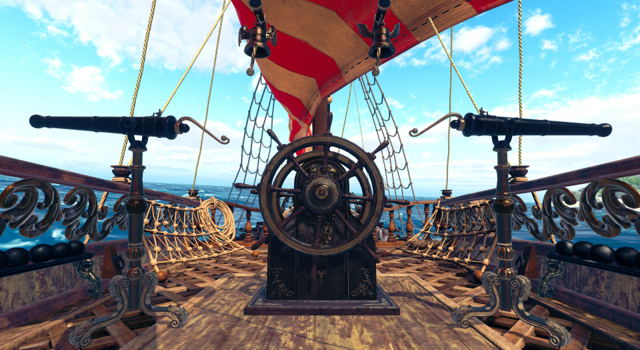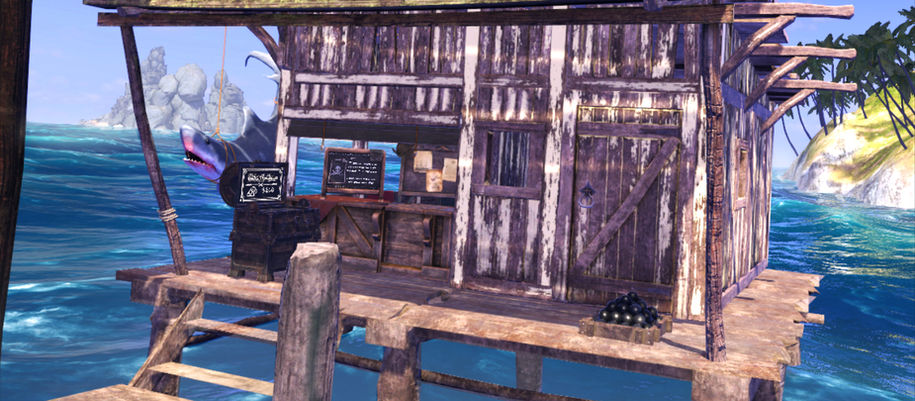

***Due to the nature of my NDA, I am unable to share the concepts and designs I produced during my work on Furious Seas.***
About:
Furious Seas is a VR Naval-Combat Action title that puts you in command as the captain of a deadly pirate ship. Navigate your way through an open world as you hunt down the members of the Crimson Bandits, a band of murderous thieves that robbed you of your fortune and left you for dead on foreign isles. As you strike each name off your list and collect their bounty, build your arsenal and upgrade your vessel to take on tougher challenges and opponents. As the story unfolds, carve out your legend as the greatest pirate amongst the Furious Seas.
for more info visit: http://furiousseas.com/
I worked on Furious Seas with a team of 6 other individuals for the span of 8 months. During this time, I was responsible for transforming the content of Furious Seas from a simple Arcade-Style Wave Shooter, into an Action-Adventure RPG title. We added 3 new chapters, each featuring 2 unique levels, A boss and new weapons for the player. I designed multiple systems, including a bounty board, shops to purchase weapons and ships, as well as an open-world navigation system. To see a full list of all the content I played a hand in developing, please see take a look at the this section.
My Role:
Game Designer &
Production Assistant
As Game Designer, I was responsible for:
► Conceptualizing, designing, and developing new systems and levels for the game, including trading systems, navigation, boss combat, and more.
► Transforming the genre of the game from an arcade-shooter to more of an RPG-adventure genre.
► Communicating design ideas to peers using visuals, graphs & prototypes.
► Collaborating with programmers and artists to test & validate design ideas before implementation.
► Prototyping & testing game features, in-engine, using Unity & C#.
► Creating & developing entire levels, including enemy & checkpoint placements, item drops, level, level rewards, sentry placement, etc.
► Writing the game narrative and dialogue for all characters and NPC's
► Documenting all game elements, including narratives, systems & designs, on Confluence.
► Playtesting and managing quality assurance for all features, while also balancing and tuning mechanics.
As a Production Assistant, I was responsible for:
► Managing all outgoing and incoming communication for the team. This includes all email management, as well as community management (Steam, Discord, Canny, Reddit).
► Outsourcing contracts with sound designers, voice actors, and others.
► Seeking licenses for purchasable assets and content.
► Building various pitch-decks, presentations, and applications to acquire funding from grants and publishers; most notably for CMF, OMDC, and publishers at MIGS.
► Handling Business Development and CRM by seeking and meeting with potential funders & publishers.
For a full list of content produced during my tenure on Furious Seas, please check the following steam posts:
Design Goals:
Our team was dead set on trying to create something empowering for the player. We used 3 Pillars to hone our focus on what Furious Seas would be.
-
Powerful Pirate Lord - Provide the player with the right controls, tools and weapons to feel like a real life Bad-Ass Pirate. Focus on progression, arsenal building and work towards ship upgrades.
-
Artistic Realism - The world around should feel like the player is sailing through the carribean isles. We focused on realistic water shaders, terrain and textures, while working with the limitations of the Oculus Rift & an older version of the Unity Engine.
-
Explore the Open Seas - We want the player to use their navigation skills and explore as much open water as possible. We did not want to artificially restrict the players movement, by land locking them. We want to entice them to check out places they see in the distance, and explore nooks and crannies.
Post Mortem:
Resource Management & Scheduling
Our studio was tight on resources, yet overly ambitious for the amount of content we beleived we could fit in before our imminent lay-offs. Management had laid out a plan and road-map for the coming 8 months that we dedicated solely to Furious Seas that even I thought was un-feasable given the time and constraints of a mostly Jr. dev team. We had planned for many systems that we designed, prototyped and implemented a great deal for, which had to be cut.
Cutting content is not anything to blink at in the games industry. However, given our deadline, the time and energy that went into these cut features, could have easily been used to enhance the content that DID make it into the game. Designing and developing on the fly while getting so near a deadline, did not feel like the right time to get too explorative in the features and systems we could include. In hindsight, it would have been smarter to enhance the visual story-telling of the game and focus on game progression and options for play style (different ammo and ship types).
Additionally, we were scheduled into crunch for the majority of our development. We averaged 6 day weeks at full time, and this ate into the overall satisfaction and motivation of our workforce. We could have done better to make our sprints go at interval ever few weeks instead. This would have hastened the amount of work done because the team began to fatigue in the last few months of development and our progress began to slow.




















